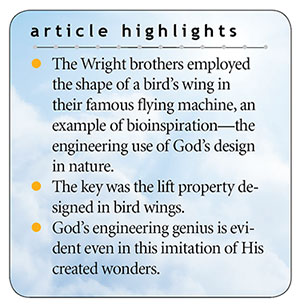 Humans have been endeavoring to soar like birds for millennia. After multiple failures, many people felt that manned, mechanized flight was impossible. After three years of test flights, Wilbur and Orville Wright’s first successful airborne attempt finally achieved the dream of mechanized flight in 1903, and it changed the world. And “throughout the story of the Wright brothers…birds figure prominently.”1
Humans have been endeavoring to soar like birds for millennia. After multiple failures, many people felt that manned, mechanized flight was impossible. After three years of test flights, Wilbur and Orville Wright’s first successful airborne attempt finally achieved the dream of mechanized flight in 1903, and it changed the world. And “throughout the story of the Wright brothers…birds figure prominently.”1
They were no doubt inspired by the mention of birds 53 times in the Bible, such as “ask…the birds of the air, and they will tell you.”2 The brothers were largely self-taught but voracious readers who experimented with mechanical things throughout their lives.3 Their church had long been openly creationist and very opposed to Darwinism. In harmony with that commitment, the brothers perused books such as English biologist St. George Jackson Mivart’s detailed anti-Darwin book On the Genesis of Species.4
Wilbur and Orville realized that if birds could fly, humans could copy their design and likewise be able to fly. Their mother loved birds and could identify a bird by its song. She taught this love to her sons.5 After observing birds effortlessly gliding for long distances, they concluded that if a “bird’s wings could sustain it in the air without the use of any muscles, we do not see why man could not be sustained by the same means.”6
The brothers recognized a critical factor was the bird wing’s shape, which they endeavored to copy. Observing birds was one way their approach to flight differed significantly from contemporary experimenters whose focus was on developing more-powerful engines. The brothers focused on wing design. Specifically, the wing needed to be curved to force air on top to travel faster than air underneath. Faster-moving air has less pressure, creating lift from the air below the wing. Their notebooks include detailed notes on bird flight that help historians determine what they learned from birds.7
They also studied other flying experiments, which they compared “with their careful observations of soaring birds.” Wilbur noticed that a buzzard maintained its “balance in the air chiefly by twisting its dropped wing. This twist increased the air pressure on the dropped wing and restored the bird to level flight.”8
The brothers copied this design to enable their flying machine to bank or lean into a turn just like a bird. After two years of experiments, they realized the existing scientific data were wrong.9 Using a small, homebuilt wind tunnel, they collected accurate data that enabled them to construct more-efficient wings and propellers.
We can see God’s engineering genius even in this pale imitation of His created avian wonders. ![]()
The human engineering of devices inspired by design in the natural world is called bioinspiration, a field that has grown both in size and importance in the years since the famous flight.10 The Wright brothers’ example is only one of thousands. From “studying God’s creation in the form of bird-flight, they were helped to develop their own creation of a better aircraft.”11 Indeed, very few men have changed the world in greater ways than the Wright brothers, and they started by watching “the birds of the air.” We can see God’s engineering genius even in this pale imitation of His created avian wonders.
References
- Combs, H. and M. Caidin. 1979. Kill Devil Hill: Discovering the Secret of the Wright Brothers. Boston: Houghton Mifflin, 109.
- Job 12:7.
- Moolman, V. 1980. The Road to Kitty Hawk. Alexandra, VA: Time-Life Books, 107-108.
- Mivart, S. G. J. 1871. On the Genesis of Species. New York: D. Appleton and Company.
- Reynolds, Q. J. 1978. The Wright Brothers, Pioneers of American Aviation. New York: Random House.
- Moolman, Road to Kitty Hawk, 111.
- Combs, Kill Devil Hill, 109-111.
- Eimerl, S. 1964. The History of Flight. New York: Golden Press, 29.
- Ash, R. 1974. The Wright Brothers. London: Wayland Publishers, 41.
- Forbes, P. 2006. The Gecko’s Foot: Bio-inspiration: Engineering New Material from Nature. New York: W. W. Norton & Co.
- Lamont, A. 1991. The Wright Brothers: Pioneers of the Skies. Creation. 13 (4): 24-27.
* Dr. Bergman is Research Associate at the Institute for Creation Research and a former adjunct associate professor at the University of Toledo Medical School in Ohio.


















